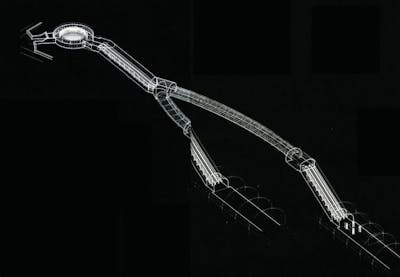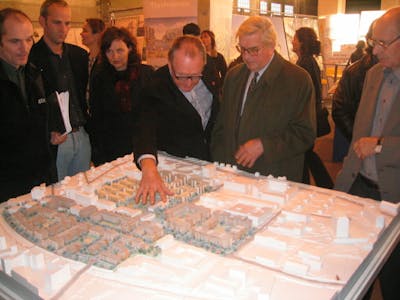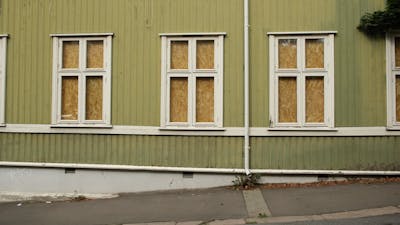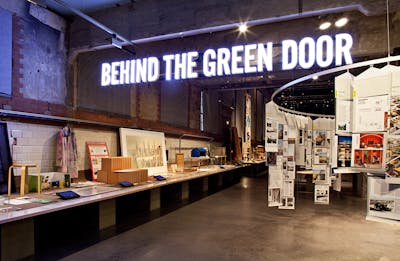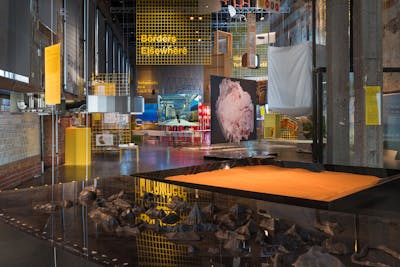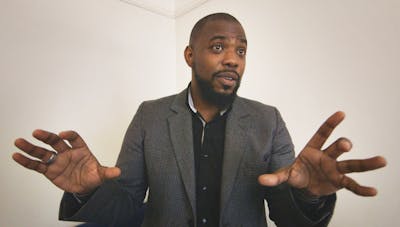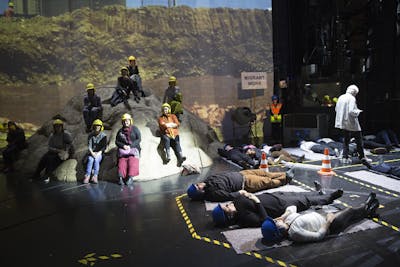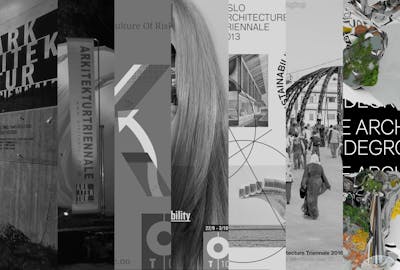The publication B-Sides was part of the Oslo Architecture Triennale of 2007. The idea of pulling together a collection of non-winning entries to Norwegian architectural competitions, it sought to explore those unbuilt ideas, what they represented about ambition, risk and innovation.
Ingerid Helsing Almaas, the editor-in-chief of Arkitektur N at the time, asked questions such as “what is the motivation for innovation?”, in an argument connecting notions of innovation and risk
in construction in her opening editorial. Following this, there was a transcription of a conversation around wider themes of risk. Working with Almaas were the co-founder of Snøhetta architects Kjetil Thorsen, post-doc researcher in architecture at the Oslo School of Architecture and Design Mari Lending, curator of the 2007 Triennale Gary Bates, and former editor of Arkitektur N magazine Einar Bjarki Malmquist.
Having looked over her essay and the conversation transcript, I asked Almaas what her thoughts on it were thirteen years later:
Ingerid Helsing Almaas: What we were trying to get to grips with in the conversation, reading it now, was specifically the nature of risk as it applies to architecture. And it was difficult to navigate through all the different understandings of what that word means, in different contexts. The risk associated with building projects is usually defined as either technical or economic, and the kind of risks that we were discussing in that conversation are on a different level.
Will Jennings: I could see these different approaches to the idea of risk, and I think it was interesting – so for instance when Mari Lending says “To risk something is to bet something, it is a game, you can lose, and you can win.” and she gave the example of climbing onto the new opera house roof and looking back over the city, I sensed that as a kind of risk but it struck me as a very low level risk in terms of what the word could mean.
IHA: I very much like the metaphor of the boat that Einar Bjarki Malmquist introduced – to build the boat is in itself a risk, because the journey will be a risk, but your boat has to be a very, very solid boat, there is no risk allowed in that construction. So there is something there about the solidity and the “non-riskiness”, if you like, of construction that has to be absolute. The corners have to meet, there is no risk to be taken there, but then what the construction is for, the way it’s received, and the way in which architecture acts in society in different ways can be risky. And what we architects in the conversation discussed, as I read it now, is how much is actually known about how that works.
I happen to know very well the site architect for the Oslo Opera House. Several times I’ve asked him questions about the roof, because this roof that you could walk on kind of surprised everybody. And yes, the architects were obviously able to predict that when you can build something people will walk on it, but I don’t think they were in control of the cultural reception of that experience, and nor in control of the processes of reception that have taken place. And when you look in the B Sides issue for example at the Behnisch Architekten drawings for their opera house entry, where none of the lines meet – they’re totally hopeless as architectural drawings, but very interesting as a presentation of a project.
WJ: There’s something about competition entries and unrealised ideas that I have always found interesting. For instance, in many ways I preferred the paintings of Zaha Hadid to her buildings, because as soon as they became solid and the lines had to meet you could see the junctions and details, and it wasn’t quite as hypnotic. It was too solid to have that hypnotism. So I guess that’s where risk and imagination turn into sculpture, and the risk is removed?
IHA: Well, yes and no. And that’s why I think the metaphor of the boat is so interesting. I remember [Australian architect and Pritzker Prize winner] Glenn Murcutt pointing at the gutters on one of his buildings that I went to see. He knows all the fifty different species of eucalyptus that grow in the various parts of Australia where he builds, and in order for the leaves of the eucalyptus growing at this site to go down the drain and not clog up the gutters the diameter of the hopper had to be precisely right – incredibly finely tuned and constructed projects, like boats. But I think, in a way, no less risky than the kind of life, the kind of culture that they open up for. It’s maybe a discussion of freedom as much as a discussion of risk.
We didn’t touch on freedom in the conversation, but that is maybe a discussion that would still be interesting, because in the end what are you trying to do with “risky” architecture? To my mind, the important thing is that you try to open up for a different kind of life, or to take a longer step into the future than you would otherwise.
WJ: One thing I thought about again and again while reading the conversation – and which I think wasn’t really picked up on – is the idea of who is taking the risk. Some designers may claim they are always taking risks, trying new things, but often they are using public money and land. There is frequently the sense that the risk is somebody else’s – an innocent person’s quality of life, or money. So there are ethics involved, and I think that’s a really important question now.
IHA: It is, and I think a lot of architects are not making it sufficiently clear what the gain is when you take that risk. In the world of finance when you take a risk it’s always because you want to gain something. Money. The aim is always clear. If the architect’s aim is ultimately to gain an aesthetic experience, or the experience of constructing a particular aesthetic experience, then I don’t think that’s a sufficient gain. And if architects perceive what they are delivering is something so valuable as an aesthetic experience that society should be able to allow itself that luxury, or take that risk, then it needs to be explained in those terms. So the gain of architectural risk is insufficiently clear. That would also have been an interesting discussion at the time.
I think what’s also interesting in in the conversation we had is the is the question of different kinds of risk – is the architecture taking a technological risk, for example? I wrote in my editorial that the gain from the Norwegian oil exploration was sufficient for us as a nation to take the risk. Actually, oil infrastructure is not very risky construction: it is huge and innovative but you can bet they did their calculations five hundred times over to make sure the risk was minimal.
In fact, the Norwegian construction industry today is full of project managers who have taken their quality control and risk management systems from the oil industry. And so a lot of the time I think the process use both belt and braces, as it were, because normal on-land construction is not as demanding. I once sat in on a risk management workshop for a construction project in the public sector, and I said, “What about the risk of bad architecture?” Not bad architecture as in a shit aesthetic experience, but what if the functional fit of the building was not compatible with long term functional aims? For example, is the building sufficiently flexible, is it possible to change it in twenty years’ time, is there a circular use of materials etc etc? These are also risks. But they hadn’t thought of that, because their system was conceived for engineering. So actually there are risks that have not been identified because the systems aren’t developed for that purpose.
WJ: In the opening editorial to the B-Sides issue of Arkitektur N, you wrote “it’s only when it’s obvious to everyone that this is where we are going that we must enter into the unknown in order to find the answers that we seek, that innovation in architecture makes sense.” And there’s something there around this sense of the invisible and unknown. In the financial and oil industries there’s a “known” outcome, but in architecture you’re suggesting we have to also trust the unknown, we have to be brave.
IHA: Architecture is a propositional discipline. Which means we talk about things which are not, but that could be a good idea, and your idea as an architect is to make the leap but also to make it possible for others to understand the potential value of that leap. Where I am working now, Design and Architecture Norway, DOGA, a government-funded innovation agency, we talk a lot about the value of architecture and design as propositional with a methodology for making those leaps.
The design disciplines, particularly service design and systems oriented design, have become very experienced at creating bridges to help others cross. They have a lot of methods used to visualise and make clear what could be possible. Architects are not so far along that line. We still have the drawing and the picture of a future building as our main medium, but not a clear and explicit methodology that allows us to collaborate, which is a shame. Architecture is requiring people to make a leap of faith, which they are understandably in many instances reluctant to make.
WJ: You have touched upon a key conceit of these series of interviews I am conducting, in that I am having conversations with people who are directly talking about architecture but not necessarily using plans, models and those traditional methods, but in processes, methodologies and other creative modes.
IHA: You can say everything is a risk: walking out into the street is a risk, so as a word it’s applicable in almost all situations. In this context you have to to direct the conversation specifically at different kinds of risks related to architecture. And I think Gary Bates was quite successful in doing that with his curating, at least pointing to the fact that there should be discussions about risk, specifically in Norwegian architecture and architectural culture. I don’t think we learned particularly well from the arguments he was offering, actually. Not as a profession and not as a society. We weren’t able to reach anyone who was actually in a position to take more or less risk as a result of the Triennale. But I think it’s interesting to revisit it now, and have more of those discussions.
I think 2007 was the year that we included key environmental information as part of our presentations, or building projects. Everyone had to submit their insulation values, their energy consumption, and use of materials and all those kinds of things, the same as you would for who worked on the project and the regular kind of project information. Now it’s second nature, everyone does it and the energy consumption is known when you plan a building, so we’ve come a long way since 2007.
WJ: Change is slow, especially in architecture, which is a slow process in and of itself.
IHA: It is, and whatever was built in 2007 still stands. So architecture, and change in architecture, is expensive, and it’s slow. But I think a discussion of risk now would be very different. I think that for example sustainability, both environmental and social sustainability, would be a very natural part of the conversation now, in a way that it certainly wasn’t then. I think the issues were technological and financial then. But now what’s most pressing is the risk of not doing something, in terms of climate for example.
WJ: Inaction. Another one of your editorial quotes is: “What we’re trying to find is not the physical final solution, but a strategy for entering the uncertain”, and I think that ties into what you’re saying about architecture as a method, or proposition, and not the objectness. Now, in terms of climate, the uncertain is becoming more certain. Still, it’s hard for to propose counter-actions, for so many reasons including geopolitics, but also because so many people don’t quite connect the abstraction of climate breakdown to the things they do every day – whether constructing a building, going to work or eating. And I think the architecture sector has to be part of that conversation in a more public way. The biggest risk is the risk we don’t take, as you say, echoing Gary in the conversation.
IHA: I would maybe rephrase that now: The biggest risk is the risk we don’t understand, somehow, or the risk that we don’t see. Because I think with climate change – to go into that discussion – we are at the limit of what humans are capable of understanding. The systems we have created and the consequences that they have are on a scale that is really incomprehensible to us.
So it’s very natural that people don’t see that their actions have consequences on that scale. And so the risk is a risk that we don’t even know that we’re taking. That risk of inaction. The risk on the scale of climate change is a risk of understanding or a risk of comprehending, or as you said a risk of inaction.
This is a different type of risk to the risk that you take if you climb a mountain or jump a crevasse, which is something immediate and obvious. But what kind of agency architecture would have in that context, I don’t know. I’m sure architects can do something, we can apply more sensible technology for sure, but I think it’s risky for architects to imagine that they can solve climate change.
WJ: We have here in Britain, and I think it’s travelled across Europe, possibly to Norway as well, an organisation set up called Architects Declare. A coming together of large practices to speak as a collective about the changes they went to make in terms of climate breakdown. They have all signed up to manifesto points, and then many more practices have co-signed. I wrote at the time in a magazine that this is great but only
if they actually stick to it, and sometimes that might involve saying “no” to or negotiating with a client. And there’s little evidence that some of the flagship companies have taken that on board – some have even signed up to design new airports since. And the thing is that a year and a half has already passed. Another year and a half, and another beyond that, and we’re way down the line. The risk is unavoidable.
IHA: There’s an Architects’ Declare in Norway as well. To be honest, I thought the points in the manifesto were really tame. They were not much more than common sense, in a way. By all means sign it, say it. But he thing is, there are so many things that architects don’t decide. If it was Clients Declare then you could get somewhere.
Anyway, climate change is a big boat, a lot of different people are on board and trying to do little things here and there. There are visionary clients as well, and there are good engineers and other consultants and people trying to do the right thing, it’s just taking too long.
WJ: I think the question of “what would the 2007 risk conversation look like now?” is extremely interesting. You talked about how environmental and social sustainability, and freedom might be a natural part of it, and areas of architecture that weren’t discussed then but maybe should be now.
IHA: I feel that in a way that around that table in 2007 there were two conversations going on, between the architects and, for example, Mari Lending and her at the time very literary understanding informing the architecture discussion. Now she has worked in the field of architecture for another decade and a half, and it would be very interesting to see how she has moved in her thoughts. It actually would be a nice exercise to have the conversation again with the same people.

